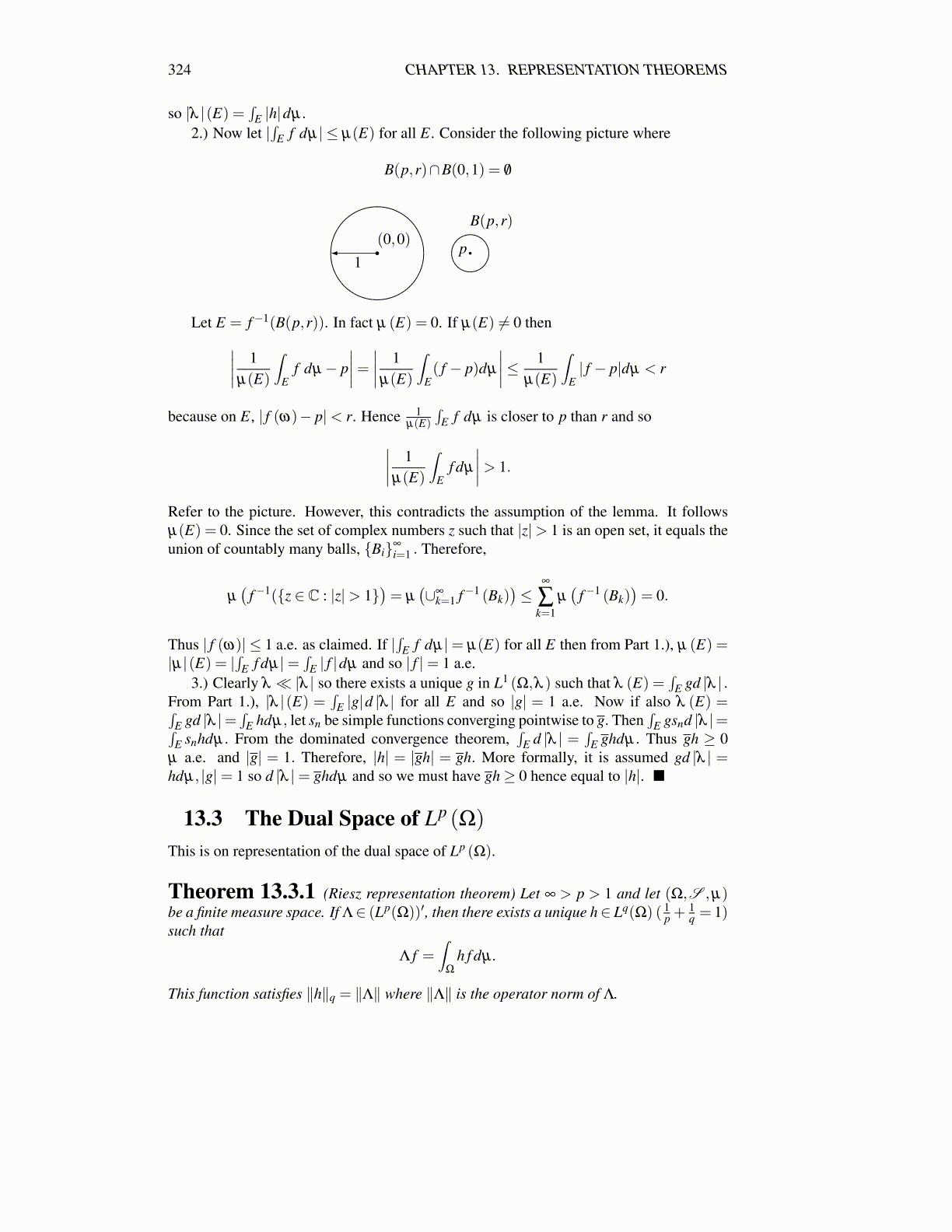
324 CHAPTER 13. REPRESENTATION THEOREMS
so |λ |(E) =∫
E |h|dµ .2.) Now let |
∫E f dµ| ≤ µ(E) for all E. Consider the following picture where
B(p,r)∩B(0,1) = /0
1(0,0)
p
B(p,r)
Let E = f−1(B(p,r)). In fact µ (E) = 0. If µ(E) ̸= 0 then∣∣∣∣ 1µ(E)
∫E
f dµ− p∣∣∣∣= ∣∣∣∣ 1
µ(E)
∫E( f − p)dµ
∣∣∣∣≤ 1µ(E)
∫E| f − p|dµ < r
because on E, | f (ω)− p|< r. Hence 1µ(E)
∫E f dµ is closer to p than r and so∣∣∣∣ 1
µ(E)
∫E
f dµ
∣∣∣∣> 1.
Refer to the picture. However, this contradicts the assumption of the lemma. It followsµ(E) = 0. Since the set of complex numbers z such that |z|> 1 is an open set, it equals theunion of countably many balls, {Bi}∞
i=1 . Therefore,
µ(
f−1({z ∈ C : |z|> 1})= µ
(∪∞
k=1 f−1 (Bk))≤
∞
∑k=1
µ(
f−1 (Bk))= 0.
Thus | f (ω)| ≤ 1 a.e. as claimed. If |∫
E f dµ|= µ(E) for all E then from Part 1.), µ (E) =|µ|(E) = |
∫E f dµ|=
∫E | f |dµ and so | f |= 1 a.e.
3.) Clearly λ ≪ |λ | so there exists a unique g in L1 (Ω,λ ) such that λ (E) =∫
E gd |λ | .From Part 1.), |λ |(E) =
∫E |g|d |λ | for all E and so |g| = 1 a.e. Now if also λ (E) =∫
E gd |λ |=∫
E hdµ, let sn be simple functions converging pointwise to g. Then∫
E gsnd |λ |=∫E snhdµ. From the dominated convergence theorem,
∫E d |λ | =
∫E ghdµ. Thus gh ≥ 0
µ a.e. and |g| = 1. Therefore, |h| = |gh| = gh. More formally, it is assumed gd |λ | =hdµ, |g|= 1 so d |λ |= ghdµ and so we must have gh≥ 0 hence equal to |h|. ■
13.3 The Dual Space of Lp (Ω)
This is on representation of the dual space of Lp (Ω).
Theorem 13.3.1 (Riesz representation theorem) Let ∞ > p > 1 and let (Ω,S ,µ)be a finite measure space. If Λ∈ (Lp(Ω))′, then there exists a unique h∈ Lq(Ω) ( 1
p +1q = 1)
such that
Λ f =∫
Ω
h f dµ .
This function satisfies ∥h∥q = ∥Λ∥ where ∥Λ∥ is the operator norm of Λ.